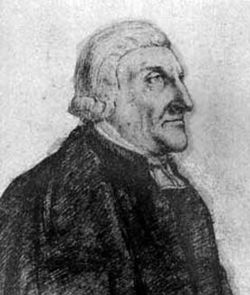John Hellins facts for kids
This article is about John Hellins (1749-1827). Don't confuse him with his grandson, John Hellins, who lived from 1829 to 1887 and was a clergyman and insect expert.
John Hellins (around 1749 – April 5, 1827) was a brilliant British man who taught himself many things. He was a schoolteacher, a mathematician, an astronomer, and a country priest. He even became a Fellow of the Royal Society, a very important scientific group.
Contents
Early Life and Learning
John Hellins was born in Devon around 1749. His family was poor, and he started his working life as an apprentice to a cooper. A cooper is someone who makes barrels.
He later became a schoolteacher. Through his hard work and with help from important people, he became an assistant to Nevil Maskelyne in 1773. Maskelyne was the Astronomer Royal, a top astronomer in Britain.
Becoming a Priest and Educator
John Hellins decided to become a clergyman, which is a priest. He served as an assistant priest, called a curate, in places like Constantine, Kerrier (from 1779 to 1783) and later at Greens Norton.
In 1789, he began studying at Trinity College, Cambridge. He was a "ten-year man," meaning he could take longer to earn his degree. He finally received his BD (Bachelor of Divinity) degree in 1800. In 1790, he became the vicar, or main priest, of Potterspury in Northamptonshire.
On November 10, 1794, he married Anne Brock. John Hellins also founded the village school in Potterspury. Today, the John Hellins Primary School is named after him.
Scientific Achievements and Recognition
John Hellins was highly respected for his knowledge in mathematics and astronomy. He became a Fellow of the Royal Society in 1796. This was a great honor for his scientific work.
Three years later, in 1799, he received the Copley Medal. This is one of the highest awards in science. He won it mainly for his paper on how to calculate the "perturbations" of planets. Perturbations are small changes in a planet's orbit caused by the gravity of other planets.
Analytical Institutions
John Hellins also oversaw the translation of an important mathematics book. It was called Instituzioni analitiche ad uso della gioventù italiana by Maria Gaetana Agnesi. This book was originally in Italian. Hellins helped publish the English version in 1801, titled Analytical Institutions in Four Books.
Praise from Davies Gilbert
In 1828, The Gentleman's Magazine published a speech about Hellins. Davies Gilbert, the president of the Royal Society, gave this speech. He praised Hellins as an extraordinary man. Gilbert said Hellins was someone who, "deprived of early advantages, have elevated themselves, by the force of genius of industry, to a level above most persons blessed with regular education." This means Hellins achieved great things despite not having many opportunities early in life.
Hellins also edited The Young Algebracist's Companion in 1787. In 1788, he published Mathematical Essays, on several subjects. He also helped with the Nautical Almanac, which helps sailors navigate. He even assisted at Greenwich Observatory. He provided calculations to William Windham for a new military system in 1806.
John Hellins also wrote many articles for the Philosophical Transactions, a famous scientific journal. These included papers on:
- How to add up series of numbers.
- How to make slow calculations faster.
- How to use these methods for logarithms and checking circular areas.
- How to find the roots of equations.
- A method for calculating planetary perturbations more easily (for which he won the Copley Medal).
He also wrote mathematical articles for the British Critic journal from 1795 to 1814.
Later Life and Death
John Hellins retired to the small parish of Potterspury in Northamptonshire. He had one son, William Brock Hellins, with his wife Anne. Anne died a short time after him.
John Hellins passed away in Potterspury on April 5, 1827. He was 78 years old. A small marble tablet in the parish church of St. Nicholas remembers him and his wife. It reads:
In Memory of
The REVD. JOHN HELLINS, B.D. & F.R.S.
upwards of 36 years Vicar of this parish, who died April 5th 1827
aged 78 years.
of ANNE HELLINS his widow, who died June 3rd 1827. Aged 72.


